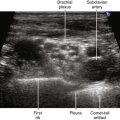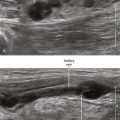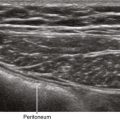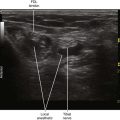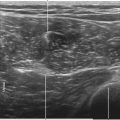1 Ultrasound
Ultrasound waves are high-frequency sound waves generated in specific frequency ranges and sent through tissues.1 How sound waves penetrate a tissue depends on the range of the frequency produced. Lower frequencies penetrate deeper than high frequencies. The frequencies for clinical imaging (1-50 MHz) are well above the upper limit of normal human hearing (15-20 KHz). Wave motion transports energy and momentum from one point in space to another without transport of matter. In mechanical waves (e.g., water waves, waves on a string, and sound waves), energy and momentum are transported by means of disturbance in the medium because the medium has elastic properties. Any wave in which the disturbance is parallel to the direction of propagation is referred to as a longitudinal wave. Sound waves are longitudinal waves of compression and rarefaction of a medium such as air or soft tissue. Compression refers to high-pressure zones, and rarefaction refers to low-pressure zones (these zones alternate in position).
As the sound passes through tissues, it is absorbed, reflected, or allowed to pass through, depending on the echodensity of the tissue. Substances with high water content (e.g., blood, cerebrospinal fluid) conduct sound very well and reflect very poorly and thus are termed echolucent. Because they reflect very little of the sound, they appear as dark areas. Substances low in water content or high in materials that are poor sound conductors (e.g., air, bone) reflect almost all the sound and appear very bright. Substances with sound conduction properties between these extremes appear darker to lighter, depending on the amount of wave energy they reflect.
Audible sounds spread out in all directions, whereas ultrasound beams are well collimated. The frequency of sound does not change with propagation unless the wave strikes a moving object, in which case the changes are small. The product of the frequency and wavelength of sound waves is the wave speed. Because the speed of sound in soft tissue is nearly constant, higher-frequency sound waves have shorter wavelengths. Two adjacent structures cannot be identified as separate entities on an ultrasound scan if they are less than one wavelength apart. Therefore, sound wave frequency is one of the main determinants of spatial resolution of ultrasound scans.

